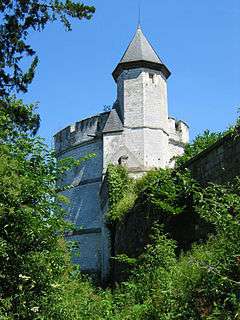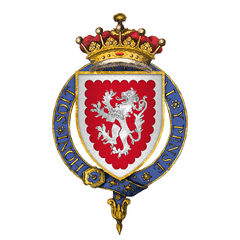John Grey, 1st Earl of Tankerville
| John Grey | |
|---|---|
|
Earl of Tankerville Lord of Powys, jure uxoris | |
|
Arms of Sir John Grey, 1st Earl of Tankerville, KG | |
| Spouse(s) | Joan de Cherleton |
|
Issue | |
| Father | Sir Thomas Grey |
| Mother | Joan Mowbray |
| Born | after 1384 |
| Died | 22 March 1421 |
John Grey, 1st Earl of Tankerville, 6th Lord of Powys jure uxoris, KG (after 1384 – 22 March 1421) was an English peer who served with distinction in the Hundred Years' War between England and France under King Henry V.
Family

The Grey family were descended from Sir Thomas Grey who during the reign of Edward III settled at Heton, Islandshire in Northumberland, and married an almost unknown gentlewoman named Agnes. He fought many wars for the English king on the Marches of the Scottish borders, dying about 12 March 1343/44. He was succeeded by his son, Sir Thomas Grey who married Margaret, daughter William de Pressene, of Presson, Northumberland.Pugh 1988, pp. 103, 187, 196 Sir Thomas fought in many battles, besieged castles, and wrote down the events in a celebrated historical account of the campaigns known as Scalacronica. He died shortly after its publication in about 22 October 1369, leaving the third Sir Thomas Grey, aged only ten years.[1]
- Sir Thomas Grey, who married Alice Neville, the daughter of Ralph de Neville, 1st Earl of Westmorland. He was executed 2 August 1415 for his part in the Southampton Plot.[2]
- Sir Henry Grey of Ketteringham, Norfolk, who married Emme Appleyard.[3]
- William Grey (Bishop of Lincoln) (d.1436).[4]
- Maud Grey (1382–1451), who married Sir Robert Ogle (d. 12 August 1436) of Ogle, Northumberland.[5]
John Grey was the second son of Sir Thomas Grey (1359– 26 November 1400) of Berwick and Chillingham Castle. His wife was Joan Mowbray (d.1410), the daughter of John de Mowbray, 4th Baron Mowbray and 1st Duke of Norfolk by Elizabeth de Segrave, daughter and heiress of John de Segrave, 4th Baron Segrave. Through his mother, a granddaughter of Margaret, Duchess of Norfolk (d.1399), John Grey was a descendant of King Edward I.[6]
king's knight of Hundred years war
Between 1408 and 1413 Henry V granted Grey three annuities, and on 8 August 1415 gave him the forfeited estates of his brother, Sir Thomas Grey, executed for his part in the Southampton Plot.[7]
Grey fought at Agincourt in 1415.[8] On 1 August 1417 Henry V launched his second invasion of Normandy,[9] and in that year Grey was Captain of Mortagne in October 1417,[10] and was with the King at the siege of Caen,[11] where his valiant conduct caused the King to name him a Knight of the Garter. Henry V granted the castle and seigneurie of Tilly in Normandy in November 1417, recently forfeited by Sir William Harcourt,[12] a supporter of the King's enemies.[13]
Grey was subsequently sent with a guard to Powys to bring the recently captured Lollard leader, Sir John Oldcastle, before Parliament.[14]
In 1419 he was again in France as Captain of Mantes,[15] and on 31 January of that year was granted the comté of Tancarville in Normandy[16] to hold by homage and delivery of a bascinet or helmet at the castle of Roan on Saint George's Day each year.[17] Grey's continued service in the French wars earned him further grants, and he was made governor of the castle of Tournay.[18] In 1418 or on 31 January 1419 he was created a Knight of the Garter.[19] In 1420 he was Captain of Harfleur,[20] and by that date was one of the leading landowners in Normandy.[21]
On 22 March 1420/1, while fording a river near the Chateau de Beaufort at the Battle of Baugé, Grey, the Duke of Clarence, and many other of the English nobility were slain by a Franco-Scottish force, having incautiously engaged the enemy without proper preparation and with no archers in support.[22]
Marriage and issue
In 1418 Grey married Joan de Cherleton, 6th Lady of Powys (c. 1400 - 17 September 1425), daughter and co-heiress of Edward Charleton, 5th Baron Cherleton, by Eleanor Holland, widow of Roger Mortimer, 4th Earl of March.[23] In his wife's right, Grey succeeded to the title of Lord Powis with its estates, including one half of Powis Castle, the other being seized of his sister-in-law Joyce, wife of John Tiptoft, 1st Baron Tiptoft. This arrangement remained in place until Joyce's great-grandson John Sutton, 3rd Baron Dudley sold the Tiptoft portion of the castle to his nephew, the third and last Baron Grey of Powis, Joan's descendant, in the mid-1530s.[24]
Their only child was a son, Henry Grey, 2nd Earl of Tankerville (c.1418 – 13 January 1450),[25] born about 1419 in Normandy, who succeeded his father to become 2nd Earl of Tankerville.[26]
In 1425, his widow was heiress to her stepbrother, Edmund Mortimer, 5th Earl of March,[27] who had earlier been the focus of the Southampton Plot. Henry Grey was knighted in 1426 and married Antigone in France, the illegitimate daughter of Humphrey, Duke of Gloucester. During the 1430s and 1440s the French Kings Charles VI and the dauphin, Philip regained much of the territory lost to the Valois monarchy. Having lost his lands and fortune at Tancarville, the Count died on about 13 Jan 1449/50. His title became extinct.
Footnotes
- ↑ Richardson II 2011, p. 254; Pugh 1988, p. 187.
- ↑ Richardson II 2011, pp. 254, 257.
- ↑ Richardson II 2011, pp. 254–6.
- ↑ Pugh 1988, p. 187.
- ↑ Richardson II 2011, pp. 257, 390.
- ↑ Richardson II 2011, p. 254; Richardson III 2011, p. 206.
- ↑ Pugh 1988, p. 104.
- ↑ Richardson I 2011, p. 428.
- ↑ Pugh 1988, p. 155.
- ↑ Richardson I 2011, p. 428.
- ↑ Burke 1866, p. 250.
- ↑ Richardson I 2011, p. 428.
- ↑ Burke 1866, p. 250.
- ↑ Burke 1866, p. 250.
- ↑ Richardson I 2011, p. 428.
- ↑ Richardson I 2011, p. 428.
- ↑ Burke 1866, p. 250.
- ↑ Burke 1866, p. 250.
- ↑ Burke 1866, p. 250.
- ↑ Richardson I 2011, p. 428.
- ↑ Pugh 1988, p. 104.
- ↑ Milner 2006.
- ↑ Richardson I 2011, pp. 427–8.
- ↑ Letters and Papers of the Reign of Henry VIII, xiii (2), App. 6.
- ↑ Richardson I 2011, p. 428.
- ↑ Richardson I 2011, p. 429.
- ↑ Richardson I 2011, p. 428.
Bibliography
- Burke, Bernard (1866). A genealogical history of the dormant, abeyant, forfeited, and extinct peerages of the British Empire. London.
- Milner, J.D. (October 2006). "The Battle of Baugé, March 1421: Impact and Memory". History. 91 (304): 484–507. doi:10.1111/j.1468-229x.2006.00375.x.
- Pugh, T.B. (1988). Henry V and the Southampton Plot of 1415. Alan Sutton. ISBN 0-86299-541-8
- Richardson, Douglas (2011). Magna Carta Ancestry: A Study in Colonial and Medieval Families, ed. Kimball G. Everingham. I (2nd ed.). Salt Lake City. ISBN 1449966373
- Richardson, Douglas (2011). Magna Carta Ancestry: A Study in Colonial and Medieval Families, ed. Kimball G. Everingham. II (2nd ed.). Salt Lake City. ISBN 1449966381
- Richardson, Douglas (2011). Magna Carta Ancestry: A Study in Colonial and Medieval Families, ed. Kimball G. Everingham. III (2nd ed.). Salt Lake City. ISBN 144996639X
- Cokayne, George E.; Gibbs, Vicary; Doubleday, Harry A. (1949). The Complete Peerage of Great Britain and Ireland. London.
- Mosley, Charles (1999). Burke's Peerage and Baronetage. London.
External links
- Grey, Earl of Tankerville
- Milner, John D., 'The Battle of Baugé, March 1421: Impact and Memory', History, (October 2006), Vol. 91, Issue 304, pp. 484-507.
| Peerage of England | ||
|---|---|---|
| Preceded by New creation |
Earl of Tankerville 1418/1419–1420/1421 |
Succeeded by Henry Grey |
